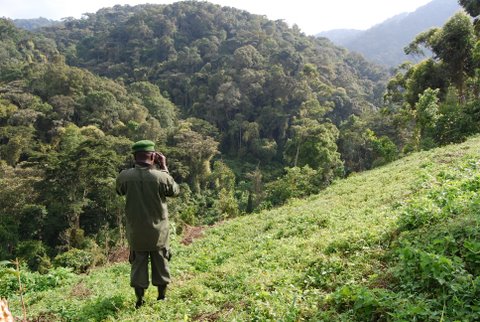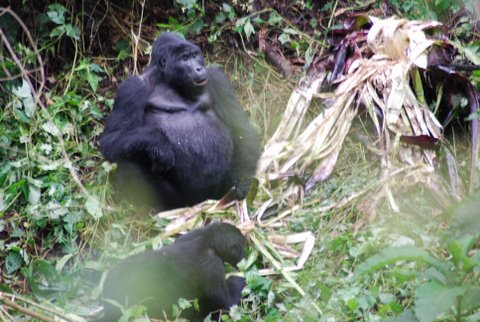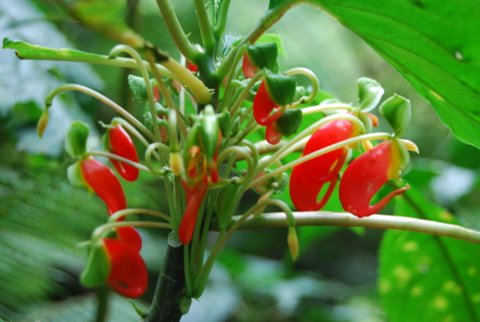Gorilla Teeth on a Perfect Morning
Benjamin, Augustin and James let out a hearty laugh. “Did you see that? It happened so fast! She definitely doesn’t like us today!” This could have been a scene from a café, where we were sitting having some coffee and all boasting, revisiting our various clumsy attempts to garner some attention. But today I was amazed that their laughs came so easily, and how their good nature and positive attitude always seems to shine. It was a bit more difficult for me because I was still quivering. Ten seconds earlier, on a perfect warm and sunny morning I had seen teeth. Huge teeth that looked the size of kitchen butcher knives.
 Bwindi Park Warden James Busiku surveying the Kanyamahene sector of the park where the Nshongi group is often found.
Bwindi Park Warden James Busiku surveying the Kanyamahene sector of the park where the Nshongi group is often found.
Our café this morning is actually a dense thicket of vines, mud and miniscule black biting insects in the Kanyamahene area of Bwindi Impenetrable National Park here in Southwestern Uganda. We are here near the smattering of houses known locally as Rushaga Village to visit the Nshongi gorillas – a large family of at least 32 (at last count) which wanders this valley and the steep ridge just ahead of us devouring whatever the fertile soil here can produce.
A few minutes ago we clung to spindly trees on a ridge that seemed to be at 90 degree angle to watch a huge blackback, pregnant female and several juveniles tear apart a wild banana tree and share the tasty pulp inside.
 Blackback from Nshongi group takes a break from his wild banana tree feast.
Blackback from Nshongi group takes a break from his wild banana tree feast.
The Nshongi group is named after the river Nshongi, which rushes through the valley here like it is late for an appointment to deposit its silty brown waters into nearby Lake Bunyonyi. The swampy area around the Nsongi, with its huge diversity of plant life, is an ideal spot for gorillas to plant themselves and eat plants: leaves, shoots, bark, stems and fruit, including the tasty wild banana. This group, which includes three huge silverbacks, a cadre of blackbacks, at least eight females, six juveniles and eight infants, is being habituated – sensitized to human presence – and soon visitors will marvel in the presence of these fascinating forest icons.
But not yet. Kaca (“Bird of Prey”), a female with a baby, today has decided to let us know we are still just visitors. While we are hacking through a wall of vines to get a glimpse of the silverback Kakono, who is mighty impressive despite the local meaning of his name – “Lame Arm” – Kaca sneak attacks us, springing like a grasshopper from the brush behind. Augustin gets a playful slap and in an instant is rolling on his back with his legs up in the air like a comedic scene from an old Charlie Chaplin movie. As Kaca whirs by, Kakono decides to join in, charging from the left, gums and teeth ablaze trampling everything in sight. James calmly orders us to bunch up and hold our ground – never run from a gorilla as they are way faster than you and WILL catch you.
But Kakona stops about eight feet (three meters) from us. He’s just testing the skinny apes. In the confusion we fail to notice Nshongi, the dominant male silverback, cocooned in another dense thicket to our right. He apparently decides it is necessary to prove he is still boss, and hurdles our way a split second after Kakona backs off. But he is just testing us as well, stopping in the mud a few meters from our right flank and turning around to casually saunter off into the swamp. Three gorillas weighing more than the six of us combined up close and personal in under 15 seconds!
Benjamin, Augustin, James and the rangers continue to laugh. It’s addictive, and I am finally able to muster a chuckle too, even though I am still bent over, cowering behind James. This is a normal occurrence with gorilla habituation, and the rangers here are all professionals who know what to do. Close encounters are part of the job. With patience, understanding and respect, the Nshongi gorillas will be ready for visitors soon. Those visitors will provide much needed income to the local area so IGCP can continue to work with the park service and our other partners to build a bright future for the gorillas and their human neighbors. The resulting community projects will, in the end, benefit everyone.
 A sample of the unique and beautiful plant life found in Bwindi Impenetrable National Park (I never did get the name of this plant... does anyone know?).
A sample of the unique and beautiful plant life found in Bwindi Impenetrable National Park (I never did get the name of this plant... does anyone know?).
I am honored to participate in this process, teeth bearing and all. A charge from 400 pounds of muscle is a small price to pay for the opportunity to serve and contribute to sustainable livelihoods. We leave Nshongi and his brood to their banana stalks and emerge from the forest as the sun begins to bake the adjacent potato and cabbage fields from which the people of Rushaga will feed their families.
A mama with her tiny baby is on guard on top of the adjacent hill to chase away raiding baboons, elephants and other hungry forest inhabitants bold enough to venture outside their verdant home. A long necked heron elegantly soars above us. I still feel a little weak at the knees. But it is a good weakness: equal parts exhilaration and satisfaction.
Rushaga’s inhabitants are looking forward to the dividends tourism will bring, and my impression is that both forest and village communities here are currently at peace. The future does indeed seem as bright as this late morning Bwindi sun.